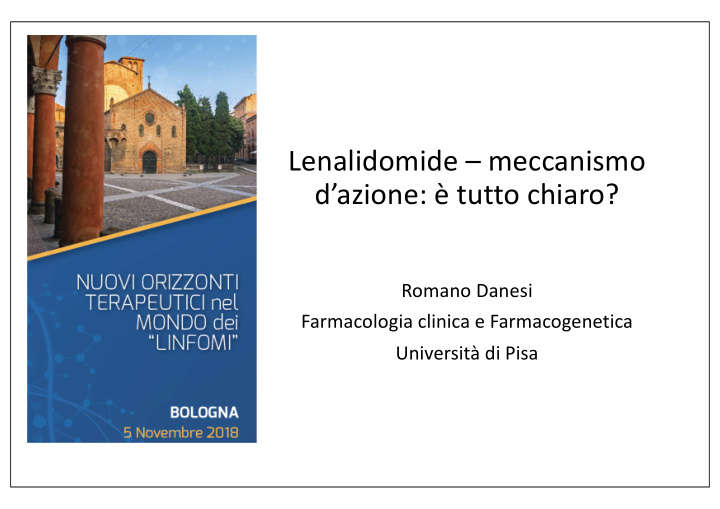



Lenalidomide – meccanismo d’azione: è tutto chiaro? Romano Danesi Farmacologia clinica e Farmacogenetica Università di Pisa
Schematic model of cereblon (CRBN) binding and differential substrates resulting in pleiotropic activity of novel drugs Grzegorz S. Nowakowski Blood 2015;126(6):698 2
Lenalidomide-induced degradation of casein kinase 1α (CK1α) CRL4: cereblon (CRBN) ubiquitin ligase List A et al. 2015 Cullin 4A: CUL4A 3
Differences between thalidomide, lenalidomide and pomalidomide Kotla V et al. Journal of Hematology & Oncology 2009, 2:36 4
Pro-apoptotic, anti-angiogenic, oxidative and CRBN-mediated effects of thalidomide combine to induce teratogenicity Shortt J et al. Oncogene (2013) 32, 4191–4202 5
Characteristics of thalidomide and the IMDs lenalidomide and pomalidomide Characteristic Thalidomide Immunomodulatory compounds Lenalidomide Pomalidomide O O O O O O H H N N N Structure N O N O N O O NH 2 NH 2 O Plasma C max , m M 7,8 2.2 a 5.4 0.19 Tumoricidal properties > 100 0.1–1 0.01–0.1 Inhibition of DNA synthesis in MM.1S cell line, IC 50 , m M 9 Immunomodulation > 100 0.15 0.010 Interleukin-2 enhancement, EC 50 , m M 10 Antiangiogenesis ~0.1 ~1.0 0.1–1.0 Inhibition of sprout formation from human umbilical artery ring explants, IC 50 , m M 11 a C max reported in ng/mL. Davies F, Baz R. Blood Reviews 24 Suppl. 1 (2010) S13–S19 6 6
Lenalidomide has tumoricidal activity and immunomodulatory effect Improves immune function and tumor killing L A D I C I R O M Lenalidomide Y U O O H R T Tumor burden O N T A N O L U D O NH 2 M O N U M I M Reduces multiple myeloma cell burden Time Davies F, Baz R. Blood Reviews 24 Suppl. 1 (2010) S13–S19 7 7
Mechanism of action of lenalidomide: tumor cell death A TUMORICIDAL Myeloma cell NH 2 o NH M Cell-cycle arrest N o Chromatin NH 2 Histone o G 0 /G 1 o NH arrest + DEXAMETHASONE N o o Caspase activation G2 G1 LENALIDOMIDE S Tumor suppressor Tumor cell gene activation Stromal Integrin apoptosis Cell I n h i b i t i o n o f t u m o r c e l l p r o l i f e r a t i o n IL-6 VEGF Reduced IL-6 and VEGF expression Reduced MM cell migration, growth, and survival Davies F, Baz R. Blood Reviews 24 Suppl. 1 (2010) S13–S19 8 8
Mechanism of action of lenalidomide: increased immune response Davies F, Baz R. Blood Reviews 24 Suppl. 1 (2010) S13–S19 9
Lenalidomide down-regulates PD-1 on tumor cells and PD-L1 on both stromal and tumor cells, thus restoring immune response Giuliani M et al. Oncotarget 2017; 8(14):24031-24044 10
Lenalidomide induces tyrosine phosphorylation of CD28 on T cells leading to activation of downstream targets such as PI3K, GRB-2-OS, and NF-κb, thus leading to T cell clonal proliferation Kotla V et al. Journal of Hematology & Oncology 2009, 2:36 11
Mechanism of action of lenalidomide: modulation of tumor microenvironment 12 Chanan-Khan AA, et al. J Clin Oncol. 2008;26(9):1544-1552.
Conclusions • IMDs have a complex mechanism of action and a pharmacologic modelling is far from being defined • Preclinical and clinical studies put forward a dual mechanism of action for lenalidomide, involving both a direct tumoricidal activity and immunomodulation. • However, it is presently unclear which mechanism(s) are responsible for clinical activity in patients responding to therapy; mechanisms themselves may also differ depending on the underlying malignancies and their tumor micro-environment. 13 13
Recommend
More recommend